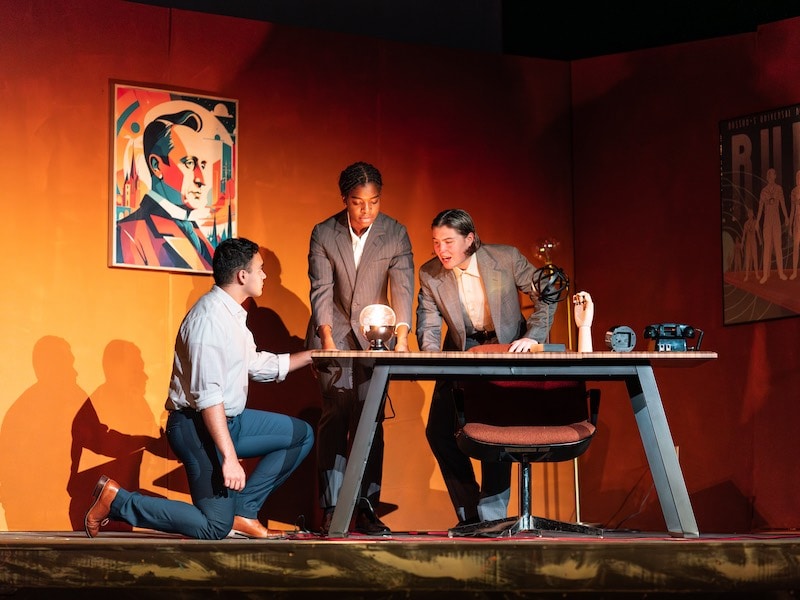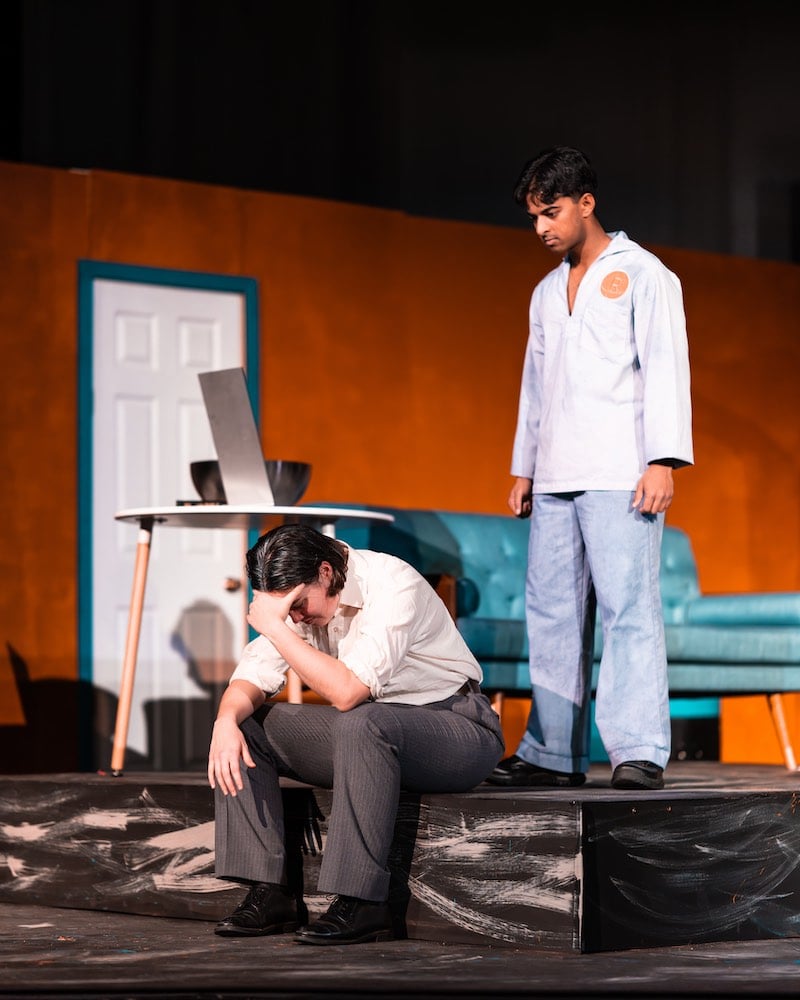The Masqueraders’ production of R.U.R.: Rossum’s Universal Robots is a powerfully dramatic adaptation of a classic science fiction tale. Karel Čapek’s 1920 play, translated by Claudia Novack, is the first work to use the word “robot.” Directed by Michael M. Wagoner, it feels of its era in some ways, while asking important questions about labor and what makes up human beings.
Dakota Caton brings a fierce ambition as Domin, head of the robot production factory. He interrupts Helena (Washington Ross) several times, then enthusiastically relates the true history of the company. He emotionally speaks of his hope to create a “paradise” where no one need work again. He is despondent when he realizes the tragedy of the situation. As a robot, Caton is cold, moving mechanically.

Washington Ross gives great passion to Helena, visiting the factory at the play’s beginning. She cannot believe how the robots are treated, pronouncing it “dreadful.” Throughout, she empathizes with the robots, trying to make them better. Toward the end, she drops to the floor weeping, before calmly delivering a verdict on the situation.
Alisha Uddin plays Nana with religious fervor, pronouncing judgment on the world for its embrace of the “blasphemy” of robots. As the secretary Sulla, she is unemotional and moves stiffly.
Olivia Hunt plays the director Alquist with a passionate hatred of “progress.” She shakes Caton as he declares his vision. Initially trying to hide her concerns from Ross, she emotionally declares her assessment of what’s going on. She dominates the stage in the end, filled with desperation and fear, ending on her knees in prayer.
Joel Thomas brings a quiet determination to Dr. Gall, the builder of the robots. Enthusiastic about his work, he emotionally declares his frustrations with the designs for one particular robot. He passionately takes the blame when things go terribly wrong. As the robot Damon he is filled with fear, shouting in pain during a horrible experiment.
Eduardo Ramirez brings enthusiasm as the director Hallemaier. He dismisses all concerns about producing robots. As the robot Primus, he is filled with love for the robot Helen (Sofia Okorafor), desperately trying to protect her and offering up himself.
Sofia Okorafor plays the director Fabry with an eagerness to promote the company’s work. She gives a childlike curiosity to the robot Helena, looking at herself in a mirror and asking profound questions.
Mary Casper brings a casualness to the director Busman. Reducing everything to economics, she quickly refutes Ross’ initial concerns with the robots. Later, she seems blissfully unconcerned with the dangers, putting her feet up on the desk. As the robot Radius, she is filled with cold rage and desire, throttling Hunt in pursuit of a secret.
Christian Landis, Lexi Betances, George Hollister, and Andre Saiz give menace as robots, moving in unison and a cool threatening edge to their voices.

Set designer George Hollister and props coordinator Leo Grisard evoke a mid-20th-century European office, with sleek chairs and a sofa. A desk in the back holds a phone and various equipment, while a small table in front has a typewriter. Pictures of the company’s founders hang on the backdrop. Costume designer Dani Bocanegra captures the era with suits, ties, and vests for the men and dresses for the women. Nana looks elderly in a long skirt and shawl. The robots wear jumpsuits. Makeup designer Lexi Betances creates a gripping visual effect in a horrifying scene.
Lighting designer Jenna Jeletic helps reflect the play’s changing atmosphere through the lights. A spotlight shines on some characters during their emotional monologues. The lights flicker when someone triggers the electric fence and darken entirely during a dramatic moment. Sound designer Enzo Constanza throws out industrial sounds like work whistles, while composer Carson Costanza adds to the drama with spooky music.
Michael M. Wagoner does a great job as director. The actors navigate the stage and each other well. From certain seats in the audience, though, the secretary’s table in the beginning briefly blocks the desk in the back. While several male roles are cleverly played by women, the play shows its age in its traditional gender roles, with the men trying to shield Helena from the terrible news and not involving her in important decisions. This creates some unintentionally humorous moments. The acoustics in Mahan Theatre are challenging; while enough can be heard to understand the story, some of the details are muffled. Miking actors might solve this issue. In our current moment of concern over artificial intelligence, R.U.R. serves as a powerful reminder that technological advances can have unintended consequences.
Running Time: Approximately two hours and 40 minutes, including a 15-minute intermission.
R.U.R. (Rossum’s Universal Robots) plays November 11, 17, and 18, 2023, presented by the USNA Masqueraders performing at Mahan Hall at the United States Naval Academy – 121 Blake Road, Annapolis, MD. Purchase tickets ($15 general, $7 midshipman) online.
R.U.R.
Rossum’s Universal Robots
written by Karel Čapek
translated by Claudia Novack




